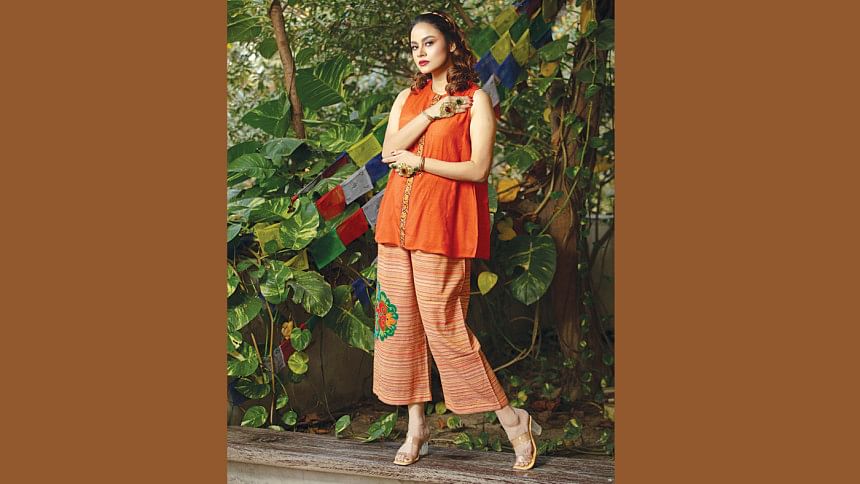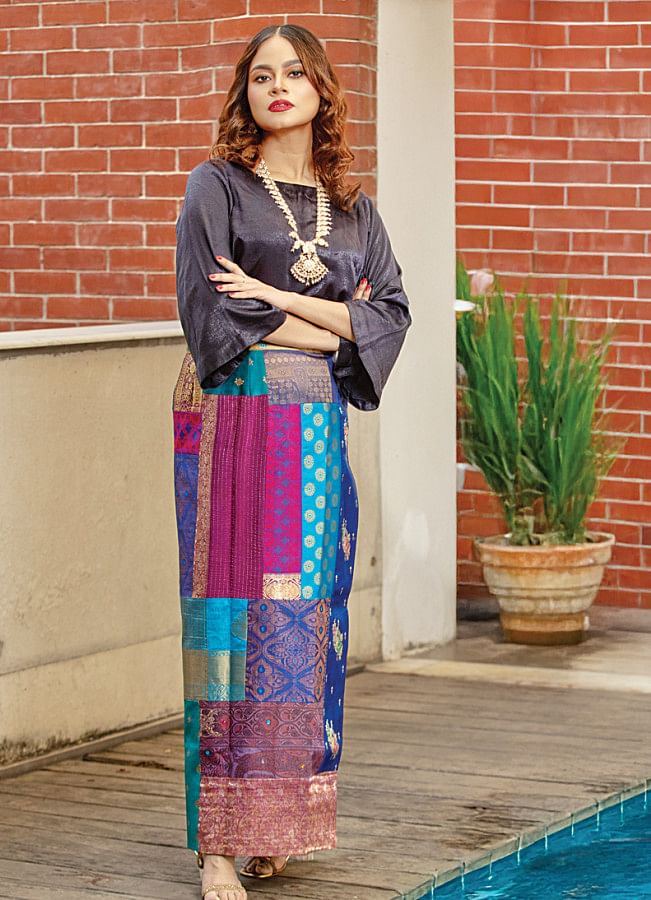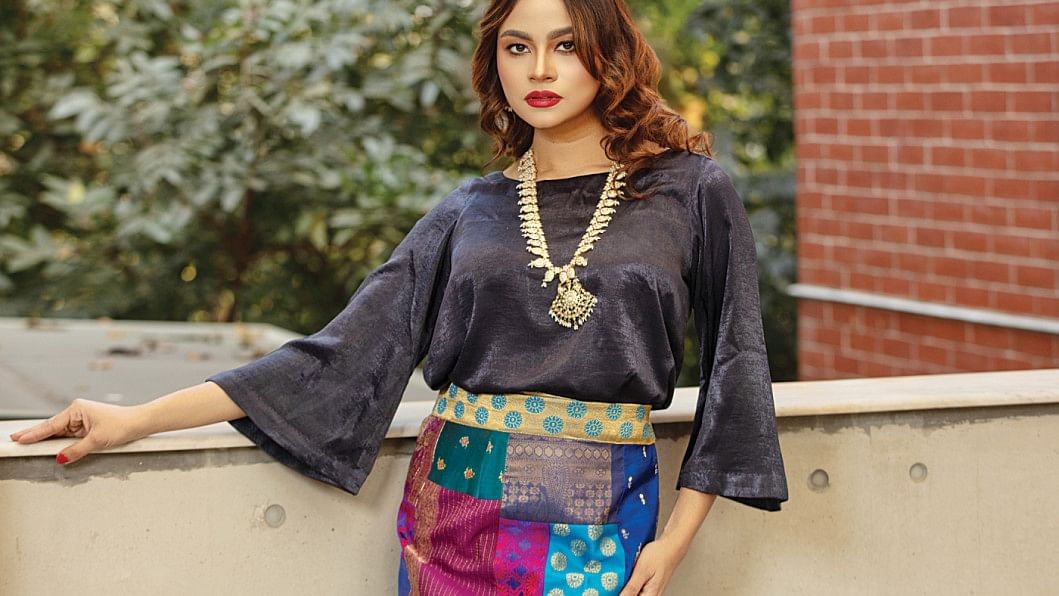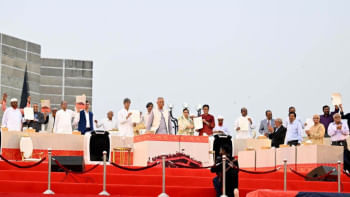How upcycling is transforming our fashion industry

In recent years, the global fashion landscape has undergone a drastic shift. Fast fashion — a business model that involves mass-producing clothing at low prices — is now under criticism for its devastating impact on the environment. The once-overlooked consequences of mass-produced clothing like polluted waters, overflowing landfills, and exploited labour, have fuelled a growing movement towards sustainable fashion.
For decades, consumers were encouraged to buy more, wear less, and discard quickly. However, as global movements have shed light on the carbon footprint of this culture, many are reconsidering their choices, and Bangladeshis are no exception.
At the heart of this revolution is "upcycling," which involves transforming old clothes into something new (recycling refers to breaking them down into raw materials for reuse). Designers and boutiques can play a pivotal role in promoting sustainable fashion as a lifestyle choice. By incorporating it into their collections, they can demonstrate the potential of discarded materials to become luxurious pieces.
Chondona Dewan, renowned designer and the owner of Chondon, is a name synonymous with patchwork styling. With over 20 years of experience, Dewan has built a reputation for turning fabric waste into stunning sarees, blouses, kameezes, and even home decor items like table runners and bed covers.
"The best part is that we do not waste anything!" she says. "My experience tells me that sustainable fashion is much easier than we make it out to be."

Dewan's creations extend beyond clothing. She crafts bags, belts, and other accessories from leftover fabric, proving that even the smallest scraps have value. For her, the journey towards sustainability is as much about rethinking habits as it is about preserving resources. The designer's commitment to sustainability is not just a business model — it's a philosophy.
People, for a long time, were unaware of the environmental damage caused by their actions. Without widespread information or platforms like social media, the consequence of pollution was often overlooked. Now, there is a growing sense of regret for having harmed the planet so carelessly.
The influence of social media campaigns in promoting sustainable fashion is also undeniable. We have celebrities being applauded for repeating their outfits; various reels on "recreating" outfits also promote the idea of upcycling perfectly.
When it comes to sustainable fashion, instead of pushing an outfit to the far corner of closets, they are taken out and reimagined. Sarees are often the starting point!
"I had a Jamdani that my mother gifted me years ago, but the edges started fraying," says Anika, an undergraduate student. "Instead of throwing it away, I turned it into a set of cushion covers and a table runner. Now, every time I look at them, it reminds me of her."

Kameezes and dresses, too, offer opportunities for re-styling. A heavily embroidered kameez that feels outdated can be deconstructed to create chic tops or even trendy fusion shirts.
"I once took an old kameez and had my tailor turn the neckline embroidery into a statement collar for my new top," shares Fahmida, a teacher. Dresses with flared bottoms or A-line cuts can be shortened to create playful and stylish tailored into smart co-ords. Every leftover fabric, every extra piece — all those broad panel designs that come and go with the trend — can be used creatively.
Shaing Shaing U Nini, Faculty and Coordinator at Bandarban University, is one of the creative minds behind the much-talked banana plant fibre, and an advocate for eco-conscious living. The pilot project, however, took a backseat despite its popularity because of lack of funding, promotion, as well as a potential market.
Based on her experience, Nini stresses, "Sustainable fashion is new. It needs to be promoted through governing bodies, as well as diversified product launches, if we want a positive outcome from it."
Her words emphasise the need for systemic change, combining individual efforts with institutional support to make sustainability mainstream.
"Sustainable fashion needs some level of machinery, even if it's handmade," she further adds. Niniexplains that while traditional craftsmanship remains the backbone of upcycling in Bangladesh, the integration of technology can help scale these efforts and make them more accessible.
Workshops, exhibitions, and fashion shows can further promote the concept of sustainable fashion. Imagine a runway featuring garments made entirely from recycled fabrics or accessories crafted from discarded materials. Such events not only inspire consumers, but also send a powerful message about the potential of upcycling.
For designers like Chondona Dewan, sustainability is also about preserving heritage.
"There is so much scope for experimenting with upcycling," she says. "We can pull from the past and bring them forward." Her patchwork creations are evidence of this philosophy, blending traditional craftsmanship with contemporary aesthetics.

The future of fashion lies in such stories of creativity and care. As consumers and designers alike embrace upcycling and recycling, they are not only reducing waste but also redefining what it means to be fashionable. "We need this sustainable fashion to be stable," says Chondona Dewan. "And this should be carried forward to the next generation."
What we must understand is that sustainable fashion is more than a trend; it is a movement that challenges us to think differently about what we wear and how we live. By turning waste into wonder, upcycling and recycling offer a pathway to a greener, more thoughtful future. As we rethink the role of fashion in our lives, one thing is clear — the most stylish thing we can wear is our commitment to sustainability.
Photo: Adnan Rahman
Model: Mashiat
Styling: Sonia Yeasmin Isha
Wardrobe: Chondon by Chondona Dewan
Jewellery: Shoilee by Tahmina Shaily
Makeup: Piash
Location: Ashraf Kaiser Residence (Arunapalli)

 For all latest news, follow The Daily Star's Google News channel.
For all latest news, follow The Daily Star's Google News channel. 





Comments